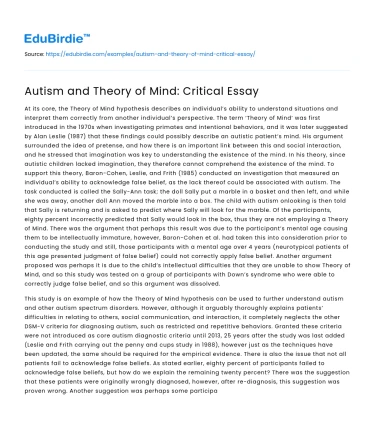At its core, the Theory of Mind hypothesis describes an individual’s ability to understand situations and interpret them correctly from another individual’s perspective. The term ‘Theory of Mind’ was first introduced in the 1970s when investigating primates and intentional behaviors, and it was later suggested by Alan Leslie (1987) that these findings could possibly describe an autistic patient’s mind. His argument surrounded the idea of pretense, and how there is an important link between this and social interaction, and he stressed that imagination was key to understanding the existence of the mind. In his theory, since autistic children lacked imagination, they therefore cannot comprehend the existence of the mind. To support this theory, Baron-Cohen, Leslie, and Frith (1985) conducted an investigation that measured an individual’s ability to acknowledge false belief, as the lack thereof could be associated with autism. The task conducted is called the Sally-Ann task; the doll Sally put a marble in a basket and then left, and while she was away, another doll Ann moved the marble into a box. The child with autism onlooking is then told that Sally is returning and is asked to predict where Sally will look for the marble. Of the participants, eighty percent incorrectly predicted that Sally would look in the box, thus they are not employing a Theory of Mind. There was the argument that perhaps this result was due to the participant’s mental age causing them to be intellectually immature, however, Baron-Cohen et al. had taken this into consideration prior to conducting the study and still, those participants with a mental age over 4 years (neurotypical patients of this age presented judgment of false belief) could not correctly apply false belief. Another argument proposed was perhaps it is due to the child’s intellectual difficulties that they are unable to show Theory of Mind, and so this study was tested on a group of participants with Down’s syndrome who were able to correctly judge false belief, and so this argument was dissolved.
This study is an example of how the Theory of Mind hypothesis can be used to further understand autism and other autism spectrum disorders. However, although it arguably thoroughly explains patients’ difficulties in relating to others, social communication, and interaction, it completely neglects the other DSM-V criteria for diagnosing autism, such as restricted and repetitive behaviors. Granted these criteria were not introduced as core autism diagnostic criteria until 2013, 25 years after the study was last added (Leslie and Frith carrying out the penny and cups study in 1988), however just as the techniques have been updated, the same should be required for the empirical evidence. There is also the issue that not all patients fail to acknowledge false beliefs. As stated earlier, eighty percent of participants failed to acknowledge false beliefs, but how do we explain the remaining twenty percent? There was the suggestion that these patients were originally wrongly diagnosed, however, after re-diagnosis, this suggestion was proven wrong. Another suggestion was perhaps some participants had a lucky guess and gave a correct judgment of false belief in several tests (Happe, 1994). However, the credibility of this explanation decreases when you consider the likelihood of guessing the correct answer every time the participant is questioned. The most likely explanation is that as mental age increases, so does the participant’s ability to correctly acknowledge false beliefs.
Save your time!
We can take care of your essay
- Proper editing and formatting
- Free revision, title page, and bibliography
- Flexible prices and money-back guarantee
Did you like this example?
Make sure you submit a unique essay
Our writers will provide you with an essay sample written from scratch: any topic, any deadline, any instructions.
Cite this paper
-
APA
-
MLA
-
Harvard
-
Vancouver
Autism and Theory of Mind: Critical Essay.
(2023, October 27). Edubirdie. Retrieved December 25, 2024, from https://edubirdie.com/examples/autism-and-theory-of-mind-critical-essay/
“Autism and Theory of Mind: Critical Essay.” Edubirdie, 27 Oct. 2023, edubirdie.com/examples/autism-and-theory-of-mind-critical-essay/
Autism and Theory of Mind: Critical Essay. [online].
Available at: <https://edubirdie.com/examples/autism-and-theory-of-mind-critical-essay/> [Accessed 25 Dec. 2024].
Autism and Theory of Mind: Critical Essay [Internet]. Edubirdie.
2023 Oct 27 [cited 2024 Dec 25].
Available from: https://edubirdie.com/examples/autism-and-theory-of-mind-critical-essay/
copy






 Stuck on your essay?
Stuck on your essay?

